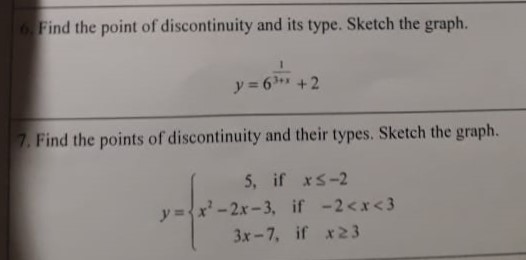Points of discontinuity?

1 Answer
Points of discontinuity are where the function is undefined.
#y = 6^(1/(x+3))+2# is only undefined when#x -> -3^+# or#x -> -3^(-)# , because#1/0# from the left or right goes to#pmoo# . For#x = -3# you would have a vertical asymptote.The range can be defined.
Below
#x = -3# , the function is increasing from right to left towards#y = 3# because#6^(1//-"large") = 1# and#1 + 2 = 3# . Approaching#x = -3# ,#6^(1//-0.0000001) = 6^(-oo) = 0# , so from the left,#y -> 2# .Above
#x = -3# ,#6^(1//0.0000001) = 6^(oo) = oo# , so the function starts high. As#x->oo# ,#y -> 6^(1//oo) = 1# , and#1+2 = 3# , so the function flattens out to give#y = 3# as#x->oo# .Therefore, the graph can be sketched as:
graph{6^(1/(3+x))+2 [-9.15, 8, 0.075, 7.725]}
#y = {(5, x<=-2),(x^2-2x-3, -2 < x < 3 ),(3x-7, x >= 3) :}# This is a piece-wise function. You just have to sketch each portion in that domain.
#y(-2) = 5# from the left, and#(-2)^2 - 2(-2) - 3 = 5# from the right, so that is a continuous connection.#y(3) = (3)^2 - 2(3) - 3 = 0# from the left, and#3(3) - 7 = 2# from the right, so there is a jump discontinuity at#x = 3# . Only the#3x - 7# point exists due to the fully open domain of the middle function.- All three functions are continuous in their own domains.
Therefore, only one discontinuity exists. I'll let you sketch this graph... Socratic has a hard time graphing piecewise functions like this.

